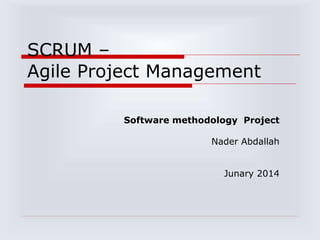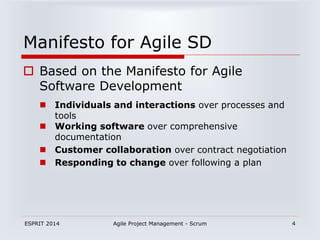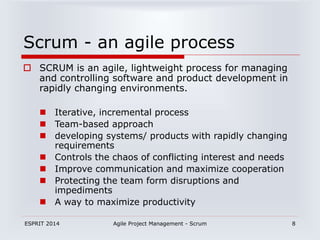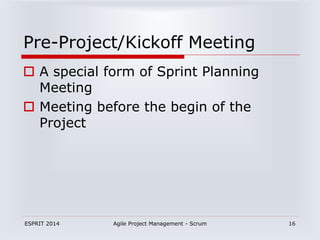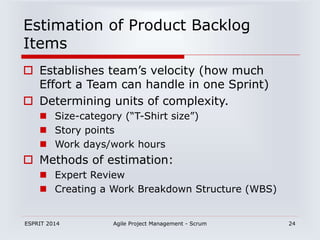Scrum Methodology
- 1. SCRUM – Agile Project Management Software methodology Project Nader Abdallah Junary 2014
- 2. ESPRIT 2014 Agile Project Management - Scrum 2 Agenda ÔÅÆ Introduction ÔÅÆ Agile Project Management ÔÅÆ What is Scrum? ÔÅÆ Functionality of Scrum ÔÅÆ Components of Scrum ÔÅØ Scrum Roles ÔÅØ The Process ÔÅÆ Scaling Scrum ÔÅÆ Conclusion
- 3. ESPRIT 2014 Agile Project Management - Scrum 3 Introduction  Classical methods of software development have many disadvantages: - huge effort during the planning phase - poor requirements conversion in a rapid changing environment - treatment of staff as a factor of production  New methods: Agile Software Development
- 4. ESPRIT 2014 Agile Project Management - Scrum 4 Manifesto for Agile SD ÔÅØ Based on the Manifesto for Agile Software Development ÔÅÆ Individuals and interactions over processes and tools ÔÅÆ Working software over comprehensive documentation ÔÅÆ Customer collaboration over contract negotiation ÔÅÆ Responding to change over following a plan
- 5. ESPRIT 2014 Agile Project Management - Scrum 6 Agile Methods  Agile methods:  Scrum  Extreme Programming  Adaptive Software Development (ASD)  Dynamic System Development Method (DSDM)  …  Agile Alliance  A non-profit organization promotes agile development
- 6. ESPRIT 2014 Agile Project Management - Scrum 7 What is Scrum? Definition from rugby football: a scrum is a way to restart the game after an interruption, where the forwards of each side come together in a tight formation and struggle to gain possession of the ball when it is tossed in among them
- 7. ESPRIT 2014 Agile Project Management - Scrum 8 Scrum - an agile process ÔÅØ SCRUM is an agile, lightweight process for managing and controlling software and product development in rapidly changing environments. ÔÅÆ Iterative, incremental process ÔÅÆ Team-based approach ÔÅÆ developing systems/ products with rapidly changing requirements ÔÅÆ Controls the chaos of conflicting interest and needs ÔÅÆ Improve communication and maximize cooperation ÔÅÆ Protecting the team form disruptions and impediments ÔÅÆ A way to maximize productivity
- 8. ESPRIT 2014 Agile Project Management - Scrum 9 Functionality of Scrum
- 9. ESPRIT 2014 Agile Project Management - Scrum 10 Components of Scrum ÔÅÆ Scrum Roles ÔÅÆ The Process ÔÅÆ Scrum Artifacts
- 10. ESPRIT 2014 Agile Project Management - Scrum 11 Scrum Master ÔÅØ Represents management to the project ÔÅØ Typically filled by a Project Manager or Team Leader ÔÅØ Responsible for enacting scrum values and practices ÔÅØ Main job is to remove impediments
- 11. ESPRIT 2014 Agile Project Management - Scrum 12 The Scrum Team ÔÅØ Typically 5-10 people ÔÅØ Cross-functional (QA, Programmers, UI Designers, etc.) ÔÅØ Members should be full-time ÔÅØ Team is self-organizing ÔÅØ Membership can change only between sprints
- 12. ESPRIT 2014 Agile Project Management - Scrum 13 Product Owner ÔÅØ Acts like one voice (in any case) ÔÅØ Knows what needs to be build and in what sequence this should be done ÔÅØ Typically a product manager
- 13. ESPRIT 2014 Agile Project Management - Scrum 14 The Process ÔÅØ Sprint Planning Meeting ÔÅØ Sprint ÔÅØ Daily Scrum ÔÅØ Sprint Review Meeting
- 14. ESPRIT 2014 Agile Project Management - Scrum 15 Parts of Sprint Planning Meeting ÔÅØ 1st Part: ÔÅÆ Creating Product Backlog ÔÅÆ Determining the Sprint Goal. ÔÅÆ Participants: Product Owner, Scrum Master, Scrum Team ÔÅØ 2nd Part: ÔÅÆ Participants: Scrum Master, Scrum Team ÔÅÆ Creating Sprint Backlog
- 15. ESPRIT 2014 Agile Project Management - Scrum 16 Pre-Project/Kickoff Meeting ÔÅØ A special form of Sprint Planning Meeting ÔÅØ Meeting before the begin of the Project
- 16. ESPRIT 2014 Agile Project Management - Scrum 17 Sprint ÔÅØ A month-long iteration, during which is incremented a product functionality ÔÅØ NO outside influence can interference with the Scrum team during the Sprint ÔÅØ Each Sprint begins with the Daily Scrum Meeting
- 17. ESPRIT 2014 Agile Project Management - Scrum 18 Daily Scrum  Is a short (15 minutes long) meeting, which is held every day before the Team starts working  Participants: Scrum Master (which is the chairman), Scrum Team  “Chickens” and “Pigs”  Every Team member should answer on 3 questions
- 18. ESPRIT 2014 Agile Project Management - Scrum 19 Questions ÔÅØ What did you do since the last Scrum? ÔÅØ What are you doing until the next Scrum? ÔÅØ What is stopping you getting on with the work?
- 19. ESPRIT 2014 Agile Project Management - Scrum 20 Daily Scrum ÔÅØ Is NOT a problem solving session ÔÅØ Is NOT a way to collect information about WHO is behind the schedule ÔÅØ Is a meeting in which team members make commitments to each other and to the Scrum Master ÔÅØ Is a good way for a Scrum Master to track the progress of the Team
- 20. ESPRIT 2014 Agile Project Management - Scrum 21 Sprint Review Meeting ÔÅØ Is held at the end of each Sprint ÔÅØ Business functionality which was created during the Sprint is demonstrated to the Product Owner ÔÅØ Informal, should not distract Team members of doing their work
- 21. ESPRIT 2014 Agile Project Management - Scrum 22 Scrum Artifacts ÔÅØ Product Backlog ÔÅØ Sprint Backlog ÔÅØ Burn down Charts
- 22. ESPRIT 2014 Agile Project Management - Scrum 23 Product Backlog ÔÅØ Requirements for a system, expressed as a prioritized list of Backlog Items ÔÅØ Is managed and owned by a Product Owner ÔÅØ Spreadsheet (typically) ÔÅØ Usually is created during the Sprint Planning Meeting ÔÅØ Can be changed and re-prioritized before each PM
- 23. ESPRIT 2014 Agile Project Management - Scrum 24 Estimation of Product Backlog Items  Establishes team’s velocity (how much Effort a Team can handle in one Sprint)  Determining units of complexity.  Size-category (“T-Shirt size”)  Story points  Work days/work hours  Methods of estimation:  Expert Review  Creating a Work Breakdown Structure (WBS)
- 24. ESPRIT 2014 Agile Project Management - Scrum 25 Sprint Backlog  A subset of Product Backlog Items, which define the work for a Sprint  Is created ONLY by Team members  Each Item has it’s own status  Should be updated every day
- 25. ESPRIT 2014 Agile Project Management - Scrum 26 Sprint Backlog ÔÅØ No more then 300 tasks in the list ÔÅØ If a task requires more than 16 hours, it should be broken down ÔÅØ Team can add or subtract items from the list. Product Owner is not allowed to do it
- 26. ESPRIT 2014 Agile Project Management - Scrum 27 Sprint Backlog ÔÅØ Is a FORECAST! ÔÅØ Is a good warning monitor
- 27. ESPRIT 2014 Agile Project Management - Scrum 28 Burn down Charts  Are used to represent “work done”.  Are wonderful Information Radiators  3 Types:  Sprint Burn down Chart (progress of the Sprint)  Release Burn down Chart (progress of release)  Product Burn down chart (progress of the Product)
- 28. ESPRIT 2014 Agile Project Management - Scrum 29 Burn down Charts ÔÅØ X-Axis: time (usually in days) ÔÅØ Y-Axis: remaining effort
- 29. ESPRIT 2014 Agile Project Management - Scrum 30 Sprint Burn down Chart ÔÅØ Depicts the total Sprint Backlog hours remaining per day ÔÅØ Shows the estimated amount of time to release ÔÅØ Ideally should burn down to zero to the end of the Sprint ÔÅØ Actually is not a straight line ÔÅØ Can bump UP
- 30. ESPRIT 2014 Agile Project Management - Scrum 31 Release Burn down Chart ÔÅØ Will the release be done on right time? ÔÅØ X-axis: sprints ÔÅØ Y-axis: amount of hours remaining ÔÅØ The estimated work remaining can also burn up
- 31. ESPRIT 2014 Agile Project Management - Scrum 32 Product Burn down Chart  Is a “big picture” view of project’s progress (all the releases)
- 32. ESPRIT 2014 Agile Project Management - Scrum 33 Scaling Scrum
- 33. ESPRIT 2014 Agile Project Management - Scrum 34 Pro/Con  Advantages  Completely developed and tested features in short iterations  Simplicity of the process  Clearly defined rules  Increasing productivity  Self-organizing  each team member carries a lot of responsibility  Improved communication  Combination with Extreme Programming  Drawbacks  “Undisciplined hacking” (no written documentation)  Violation of responsibility  Current mainly carried by the inventors
- 34. ESPRIT 2014 Agile Project Management - Scrum 35 Conclusion ÔÅØ Thanks for you attention! ÔÅØ Any questions?
